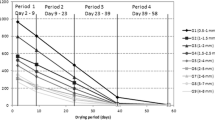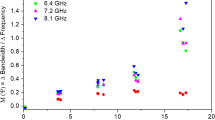Abstract
The dynamic granulation process of high-speed shear wet granulation (HSWG) was measured by in-line near-infrared spectroscopy (NIRS) and agitation power consumption (APC) methods. Molecular interactions between powder particles and the binding liquid were analyzed based on both NIRS and APC data by multivariable regression analysis. The granulated sample used glass beads (d50 = 46 μm) with or without hydroxypropyl cellulose, and the binder solution used purified water. The HSWG granulator (2-L volume) with APC device and NIRS was used, and the agitator was rotated at 600 min−1 and the chopper at 2000 min−1 with glass beads to be granulated being 920 g (0.6 L), and a total of 360 mL of purified water was added at 10 mL/min. In order to establish calibration models to predict APC and amount of binding water of the granular formulations, NIRS spectra of the granular samples were recorded every 10 s for 40 min. The calibration models to predict moisture content and APC were constructed based on the corrected NIRS spectral data by partial least-squares regression (PLSR) analysis. The relationships between actual and predicted values for moisture content and APC produced a straight line, respectively. The regression vector (RV) of the PLS model to predict the water content showed the presence of free water between the bead powder particles. On the other hand, the RV for the APC showed the presence of bound water between the particles.








Similar content being viewed by others
References
Briens L, Logan R (2011) The effect of the chopper on granules from wet high-shear granulation using a PMA-1 granulator. AAPS Pharm Sci Technol 12:1358–1365
Pandey P, Badawy S (2016) A quality by design approach to scale-up of high-shear wet granulation process. Drug Dev Ind Pharm 42(2):175–189
Badawy SF, Narang AS, LaMarche K et al (2012) Mechanistic basis for the effects of process parameters on quality attributes in high shear wet granulation. Int J Pharm 439:324–333
Pandey P, Tao J, Chaudhury A, Ramachandran R, Gao JZ, Bindra DS (2013) Combined experimental and modeling approach to study the effects of high-shear wet granulation process parameters on granule characteristics. Pharm Dev Technol 18:210–224
Badawy SF, Menning MM, Gorko MA et al (2000) Effect of process parameters on compressibility of granulation manufactured in a high-shear mixer. Int J Pharm 198:51–61
Thapa P, Choi DH, Kim MS, Jeong SH (2019) Effects of granulation process variables on the physical properties of dosage forms by combination of experimental design and principal component analysis. Asian J Pharm Sci 14:287–304
Holm P, Schaefer T, Kristensen G (1985) Granulation in high-speed mixer, part VI. Effect of process condition on power consumption and granule growth. Powder Technol 43:213–223
Holm P, Schaefer T, Kristensen G (1985) Granulation in high-speed mixer, part V. power consumption and temperature, changes during granulation. Powder Technol 43:225–233
Oike A, Terashita K, Miyanami K (1987) Review: agitating granulation in pharmaceutical manufacturing process. J Soc Powder Technol 24:535–541
Fi M, Hassanpour A, Muller F (2018) An investigation on the evolution of granule formation by in-process sampling of a high shear granulator. Chem Eng Res Des 129:403–411
Betz G, Bürgin PJ, Leuenberger H (2004) Power consumption measurement and temperature recording during granulation. Int J Pharm 272(1–2):137–149
Guidance for industry: PAT-a framework for innovative pharmaceutical development, manufacturing, and quality assurance [Internet] (2004) Department of Health and Human Services, Food and Drug Administration. Center for Drug Evaluation and Research [Accessed 2019 October 31] Available from https://www.fda.gov/media/71012/download
Singh J (2015) International conference on harmonization of technical requirements for registration of pharmaceuticals for human use. J Pharmacol Pharmacother 6(3):185–187
Blanco M, Cueva-Mestanza R, Peguero A (2010) Controlling individual steps in the production process of paracetamol tablets by use of NIR spectroscopy. J Pharm Biomed Anal 51:797–804
Jørgensen AC, Luukkonen P, Rantanen J, Schæfer T, Juppo AM, Yliruusi J (2004) Comparison of torque measurements and near-infrared spectroscopy in characterization of a wet granulation process. J Pharm Sci 93(9):2232–2243
Wu S, Panikar SS, Singh R, Zhang J, Glasser B, Ramachandran R (2016) A systematic framework to monitor mulling processes using near infrared spectroscopy. Adv Powder Technol 27:1115–1127
Luukkonen P, Fransson M, Björn IN, Hautala J, Lagerholm B, Folestad S (2008) Real-time assessment of granule and tablet properties using in-line data from a high-shear granulation process. J Pharm Sci 97(2):950–959
Mandato S, Taliani CC, Aït-Kaddour A, Ruiz T, Cuq B (2013) In-line monitoring of durum wheat semolina wet agglomeration by near water infrared spectroscopy for different water supply conditions and water addition levels. J Food Eng 119(3):533–543
Troup GM, Georgakis C (2013) Process systems engineering tools in the pharmaceutical industry. Comput Chem Eng 51(5):157–171
Candolfi A, De Maesschalck R, Jouan-Rimbaud D, Hailey PA, Massart DL (1999) The influence of data pre-processing in the pattern recognition of excipients near-infrared spectra. J Pharm Biomed Anal 21(1):115–132
Miwa A, Yajima T, Itai S (2000) Prediction of suitable amount of water addition for wet granulation. Int J Pharm 195:81–92
Miwa A, Yajima T, Ikuta H, Makado K (2008) Prediction of suitable amounts of water in fluidized bed granulation of pharmaceutical formulations using corresponding values of components. Int J Pharm 352(1):202–208
Miwa A, Makado K (2009) A method for predicting the amount of water required for wet granulation using NIR. Int J Pharm 376:41–45
Vemavarapu C, Surapaneni M, Hussain M, Badawy S (2019) Role of drug substance material properties in the processibility and performance of a wet granulated product. Int J Pharm 374(1):96–105
Gavan A, Iurian S, Casian T, Porfire A, Porav S, Voina I, Oprea A, Tomuta I (2019) Fluidised bed granulation of two APIs: QbD approach and development of a NIR in-line monitoring method. Asian J Pharm Sci online 16
Sunada H, Hasegawa M, Makino T, Fujita K, Sakamoto K, Tanino T, Kagaguchi G (1997) Study on standard formulation of raw granules for tableting compression. J Soc Powder Technol 34(10):785–795
Martens H, Naes T (1989) Multivariate calibration. Wiley, New York
Otsuka M, Mouri Y, Matsuda Y (2003) Chemometric evaluation of pharmaceutical properties of antipyrine granules by near-infrared spectroscopy. AAPS PharmSciTech 4(3):article 47
Otsuka M (2004) Comparative particle size determination of Phenacetin bulk powder by using Kubelka-Munk theory and principal component regression analysis based on near-infrared spectroscopy. Powder Technol 141:244–250
Ozaki Y, Kawada S (1996) Near infrared spectroscopy. Japan, Conference Publishing Center, pp 40-45, 216–219
Ozaki Y (2005) Non-destructive structural analysis of free and bound water in hair by near infrared spectroscopy. Jpn Cosmetol 13:9–12
Basic principles of near-infrared analysis [Internet]. (2018) Metrohm Japan Ltd. [Accessed 2020 March 13] Available from https://www.metrohm.com/ja-jp/company/metrohm_japan_applij/nir_kihon/
Shimabayashi S, Tsuji A. (2002) Modern pharmaceutics. Japan, Naneido, pp 301–310
The Association of Powder Process Industry and Engineering (APPIE) (1991) Granulation hand book. Japan, Omu sha, pp 135–146
Buckton G, Yonemochi E, Hammond J, Moffat A (1998) The use of near infra-red spectroscopy to detect changes in the form of amorphous and crystalline lactose. Int J Pharm 168(2):231–241
The Association of Powder Process Industry and Engineering (APPIE) (1991) Granulation hand book. Japan, Omu sha, pp 13–22
Funding
This research received financial support in part from Musashino University Creating Happiness Incubation (No. 23), Japan Agency for Medical Research and Development (JP19mk0101105h0102), and Earthtechnica Corporation Limited.
Author information
Authors and Affiliations
Corresponding author
Ethics declarations
Conflict of interest
The research results were achieved in a collaborative research agreement with Musashino University and Earthtechnica Corporation Limited. The authors declare that they have no conflicts of interest to disclose.
Additional information
Publisher’s note
Springer Nature remains neutral with regard to jurisdictional claims in published maps and institutional affiliations.
Rights and permissions
About this article
Cite this article
Koyanagi, K., Ueno, A., Hattori, Y. et al. Analysis of granulation mechanism in a high-shear wet granulation method using near-infrared spectroscopy and stirring power consumption. Colloid Polym Sci 298, 977–987 (2020). https://doi.org/10.1007/s00396-020-04655-y
Received:
Revised:
Accepted:
Published:
Issue Date:
DOI: https://doi.org/10.1007/s00396-020-04655-y




